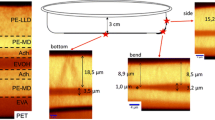Abstract
In recent years, caps with PVC-free gasket have been developed and produced in the preserved food sector and they have been gradually replacing PVC-based ones. This type of choice was dictated by the need to produce sustainable packaging from a health and environmental point of view, even in the case of this type of closure. The study dealt with two type of caps, coded “A” and “B”, with two type of PVC-free gaskets, which differ in composition and application technology. In particular, the objective of this work was to study the behaviour of these new gaskets applied to metal caps intended for packaging preserved food, both in terms of suitability for food contact and from a technological standpoint. The gaskets were primarily characterized from a chemical–physical and mechanical point of view; overall migration and ad hoc methods for the determination of the specific migration of the substances present in their formulation were set up. In parallel, the technological suitability, related to the sealing parameters of the caps applied to the glass jars and the tightness of the packs, were evaluated. About food contact compliance, both caps, comply with the Union guidelines on Regulation (UE) n. 10/2011 on overall and specific migration. From the technological point of view, for gasket coded “A”, critical issues, the vacuum seal and, therefore, the tightness of the packages were highlighted.









Similar content being viewed by others
References
Assovetro (2020) Il Rapporto di Sostenibilità Assovetro. Available via https://www.italiaimballaggio.network/it/rapporto-sostenibilita-assovetro-industria-italiana-vetro Accessed 30 Apr 2020
Assovetro (2019) Rassegna stampa packaging in vetro. https://www.assovetro.it/wp-content/uploads/2019/11/RASSEGNA-STAMPA-PACKAGING-IN-VETRO_.pdf. Accessed 7 Apr 2020
Commission Regulation (EU) 2016/1416 of 24 August 2016 amending and correcting Regulation (EU) No 10/2011 on plastic materials and articles intended to come into contact with food. https://eur-lex.europa.eu/legal-content/EN/TXT/?uri=CELEX%3A32016R1416 Accessed 24 Apr 2020
EFSA (2016) Recent developments in the risk assessment of chemicals in food and their potential impact on the safety assessment of substances used in food contact materials. https://efsa.onlinelibrary.wiley.com/doi/pdf/https://doi.org/10.2903/j.efsa.2016.4357. Accessed 21 Apr 2020
European Commission (2010) Draft commission regulation concerning plastic materials and objects intended to come into contact with food products. http://register.consilium.europa.eu/doc/srv?l=IT&f=ST%2014262%202010%20INIT Accessed 22 Apr 2020
Fankhauser-noti A, Grob K (2006) Migration of plasticizers from PVC gaskets of lids for glass jars into oily foods: amount of gasket material in food contact, proportion of plasticizer migrating into food and compliance testing by simulation. Trends Food Sci Technol 17(3):105–112
Iascone B (2018) Istituto Italiano Imballaggio
Larousse J, Brown BE (1997) Food canning technology. WILEY, Hoboken
Larousse J, Brown BE (1997) Food canning technology. Wiley, Hoboken, p 356
Larousse J, Brown BE (1997) Food canning technology. Wiley, Hoboken, p 358
Martos P, Pawliszyn J (1998) Sampling and determination of formaldehyde using solid-phase microextraction with on-fiber derivatization. Anal Chem 70(11):2311–2320
Board NPCS (2012) Handbook on fruits, vegetables and food processing with canning and preservation. Asia Pacific Business Press Inc, New Delhi
Peters K, Ramirez C (2019) Technology of fruits and vegetable processing. ED-Tech Press
Sadat-Shojai M, Bakhshandeh GR (2011) Recycling of PVC waste. Polym Degrad Stabil 96(4):404–415
Sotelo CG, Pineiro C, Perez-Martin RJ (1995) Denaturation of fish proteins during frozen storage: role of formaldehyde. Lebensmittel Untersuchung und Forschung 200:14–23
Theobald N, Winder B (2006) Packaging closures and sealing systems. Wiley-Blackwell, Hoboken
Union guidelines on Regulation (UE) n. 10/2011 concerning plastic materials and objects intended to come into contact with food products. https://ec.europa.eu/food/sites/food/files/safety/docs/cs_fcm_legis_pm-guidelines_reg-10-2011_ital.pdf. Accessed 30 Apr 2020.
Author information
Authors and Affiliations
Corresponding author
Additional information
Publisher's Note
Springer Nature remains neutral with regard to jurisdictional claims in published maps and institutional affiliations.
Rights and permissions
About this article
Cite this article
Gelati, S., Sannino, A., Bovis, N. et al. Performance Evaluation of PVC-Free Metal Caps from the Point of View of Suitability for Food Contact and Tightness of the Packaging. J Package Technol Res 5, 115–125 (2021). https://doi.org/10.1007/s41783-021-00117-0
Received:
Accepted:
Published:
Issue Date:
DOI: https://doi.org/10.1007/s41783-021-00117-0



